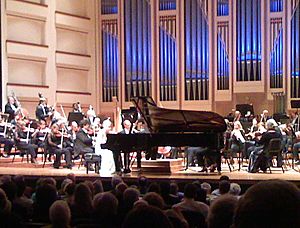Piano concerto facts for kids
A piano concerto is a special kind of music piece. It's written for a piano and a large group of musicians called an orchestra. Think of it as a musical conversation where the piano is the main star, playing exciting and beautiful parts, while the orchestra supports and talks back to it.
Contents
What Makes a Piano Concerto Special?
How Piano Concertos Are Built
Most classical piano concertos have three main parts, called movements. Each movement has a different speed and feeling:
- The first movement is usually fast and energetic. It often follows a pattern called sonata form. This part also includes a special solo section for the piano called a cadenza. The cadenza is where the pianist can show off their skills, sometimes even making up parts on the spot!
- The second movement is slow and expressive. It's often very beautiful and emotional, giving the listener a chance to relax and feel the music deeply.
- The third movement is usually fast again, often in a lively style called a rondo. A rondo means a main musical idea keeps coming back, like a chorus in a song.
Famous Composers and Their Concertos
Many famous composers followed this three-movement plan. For example, Mozart and Beethoven wrote many wonderful piano concertos that fit this model.
However, some composers liked to try new things! For instance, Liszt wrote some concertos that had only one long movement instead of three separate ones. This shows how composers can be creative and change the rules of music.
See also
 In Spanish: Concierto para teclado para niños
In Spanish: Concierto para teclado para niños


